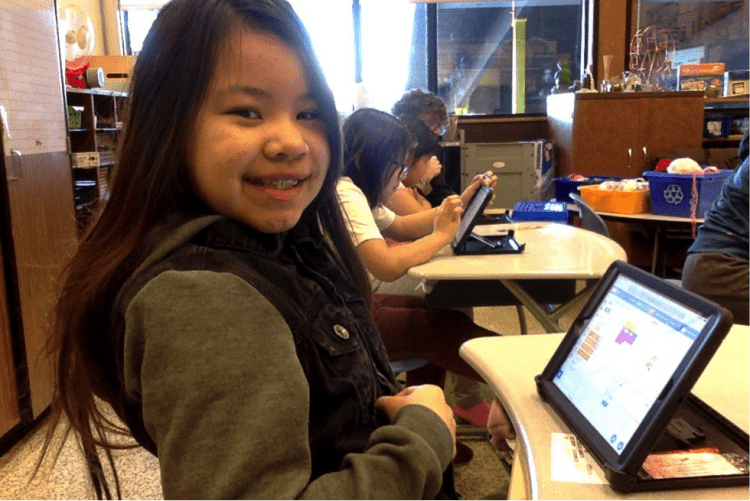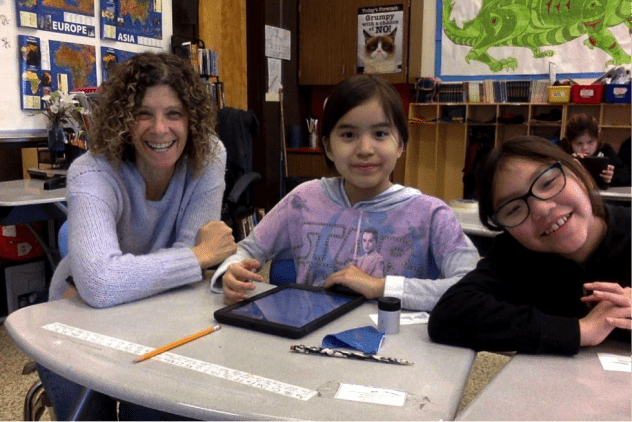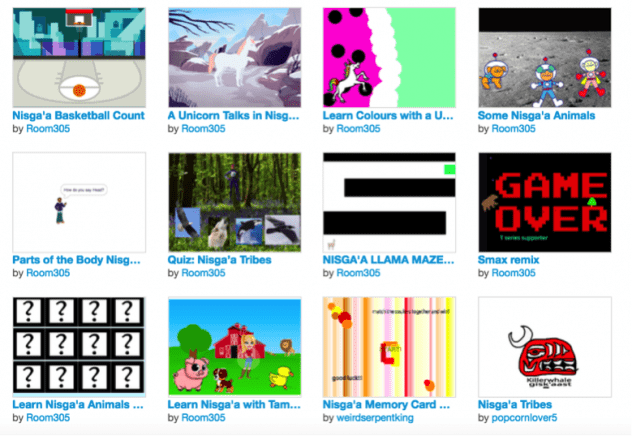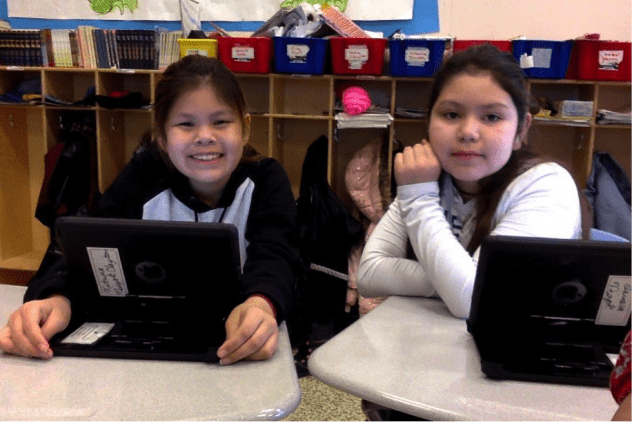By Robin Ulster and James Denby (Educators, curriculum designers, and proud members of the CIRCE Academic Council)
Storytelling is an essential element of being human. We tell, listen, and watch stories from an early age. Those stories are inextricably linked to our ability to imagine possibilities, to invent new things, and to create art. Teachers use story and imagination to ignite curiosity, to inspire students to take risks, and to understand concepts and content in every subject.
The teachers of Nisga’a Elementary Secondary School (NESS), School District #92 (Nisga’a) have always incorporated story into their classes, but this year they decided to introduce their students to a new medium of storytelling–coding and design. This year Grade 5/6 teacher, Teresa McMillan obtained grant funding to bring us to work with students in Grade 4-8 on a coding and design project to combine Nisga’a language and storytelling.
We (Robin Ulster and James Denby) visited Gitlaxt’aamiks (formerly New Aiyansh), British Columbia at the end of February 2019 to teach the basics of coding and computational thinking for a week. Using Scratch, the block-based coding language from the Massachusetts Institute of Technology’s Lifelong Learning Project, students learned about some of the fundamentals of coding and computer science, including:
- Events
- Loops
- Sequence
- Variables
- Conditionals
- Functions
In many people’s minds, coding is the opposite of an imaginative endeavour. It’s the domain of an analytical mind, a field that prizes organization and logic over creativity. Programmers, however, take strings of characters, punctuation, and numbers to create–almost from nothing–the applications and programs that run our devices, stream our films, and teach us words in new languages.
After long careers as teachers of language arts and social studies, we witnessed technology taking on a bigger and bigger role in our students’ lives with most using it as consumers, watching, listening, and reading. We wanted students to understand more about how the technology they use every day works and we wanted them to be more active in creating, connecting and collaborating with digital devices. We began our own learning journey with coding and computational thinking with this in mind.
For the past few years, we have been working with teachers to help implement and integrate ADST (applied design, science, and technology) standards (including coding) in the classroom. Teachers don’t have time to add a what amounts to a whole new subject area to their existing curricula; compartmentalizing things like coding means that a large number of students will miss out not just on valuable learning but also on potentially creative and lucrative career opportunities. We know that vast numbers of students (with girls/women, racialized groups, and students in rural areas disproportionately affected) are either missing or not seeking crucial learning opportunities in ADST.
Integrating coding, technology and design means teachers will be more likely to teach it, and it increases the likelihood that students normally drawn to the arts or humanities will see how they can use coding as a creative tool not just to express learning but to bring to life ideas for changing the world they live in.
Language Renewal Project at NESS
The teachers of NESS were determined that their students would build foundational skills in coding and design. The Nisga’a Nation, like many other First Nations in Canada, is working to rebuild interest and fluency in their traditional language. Colonialism inflicted a heavy toll on the Nisga’a language, but today there is a renewed determination to teach and learn Nisga’a.
And that’s where Teresa McMillan came in. She and her colleagues saw an opportunity to combine coding, the power of story, and Nisga’a language. In our second visit to NESS in May 2019, the goal was no longer just coding skills but the combination of coding and Nisga’a language learning and teaching. Led by Winnie Hansen, Teresa McMillan, Yvette McMillan, Larry Tait, Charity Peal and Derek Azak, students identified an audience and a problem and then brainstormed ways to teach elements of Nisga’a language.
These steps, part of the design thinking/design learning process, required students to imagine the process of learning Nisga’a from the perspective of someone else. They had to envision not only the vocabulary and language that would help describe elements of daily life in the community but also ways to make the learning experience entertaining for students of a particular age group. This meant combining imagination and an assessment of their own coding skills to plan the ‘story’ of the app–how learners would progress through the app, how their progress would be recognized, and any challenges or obstacles that would be intentionally included as part of the learning experience.
Each student determined the content of their apps. The result was a tremendous variety of language learning opportunities including games, quizzes, flashcards, and stories featuring:
- Counting and numbers (there are five ways of counting in Nisga’a)
- Local wildlife
- Colours
- Common expressions and greetings
- Family terms like mother and father
- Geographical terms like mountain and forest
Yvette McMillan, who teaches Nisga’a in grades K-8, joined every class at the beginning of the week to ensure that NESS students had the support they needed with language and vocabulary, and, by Tuesday, every student was immersed in the coding experience. Winnie Hansen, Teresa McMillan, Larry Tait, Charity Peale, and Derek Azak worked with us as we did some troubleshooting, gave advice, and used guiding questions to keep students focussed on their original plan for the app. By Friday, each student had a basic app that was ready for testing and feedback from either peers or teachers. Some students in Grade 8 elected to have students from the lower grades test their apps to see how they reacted to elements meant to make the learning experience more engaging specifically for their age group.
This was no easy feat. With only one full week of instruction in February and one week in May to plan and build an app, each NESS student had to work intensely each class period in order to meet the class deadline. The final product was often simple, but this simplicity belied the complexity of the learning and the important benefits of the process.
The prospect of creating an app in a week was a daunting prospect for many since they were essentially novice coders. By the end of our visit, however, it was clear that their confidence in their own ability to develop a plan and execute it had increased immensely. Their enthusiasm in sharing what they made was a radical change from the initial shyness we saw at the start of the week while students were beginning to work.
The use of Nisga’a in a brand new context also created new opportunities. NESS students were now in the role of teaching something that few people know. Nisga’a was no longer just a subject to learn but something to share with the world. What they built was also entirely the product of students’ own vision and imagination and therefore uniquely theirs.
NESS students are not finished their journey towards coding proficiency, but they have laid an important foundation. The confidence and enthusiasm they demonstrated has encouraged their teachers and administrators to support further learning among both teachers and staff. Teachers are seeking additional learning materials from us and from other coding resources, and, with a bit of luck, we’ll have the opportunity to return to the Nass Valley to work with NESS students and staff.





This is amazing
I agree!